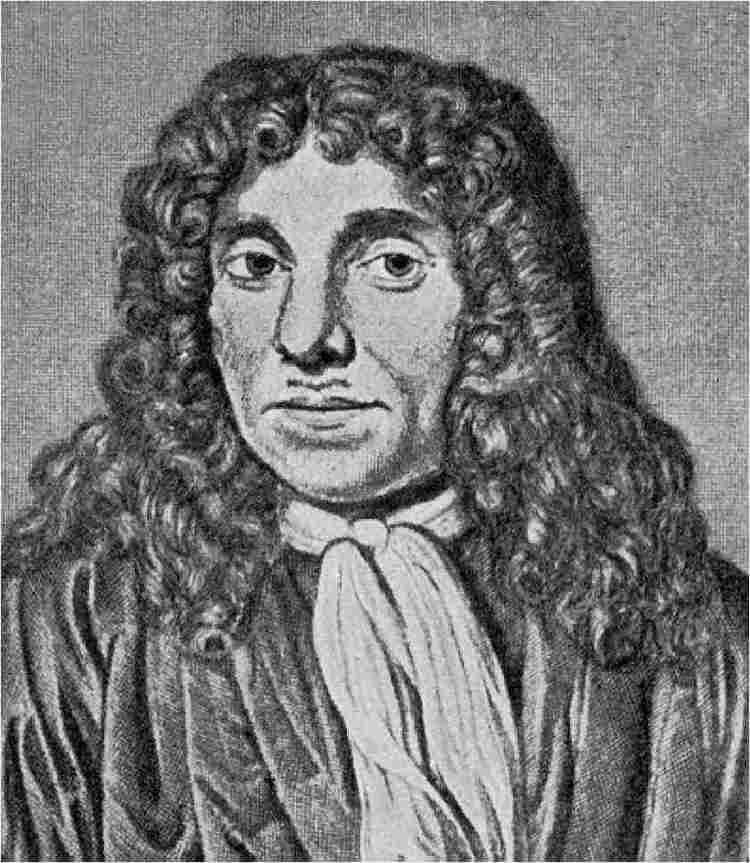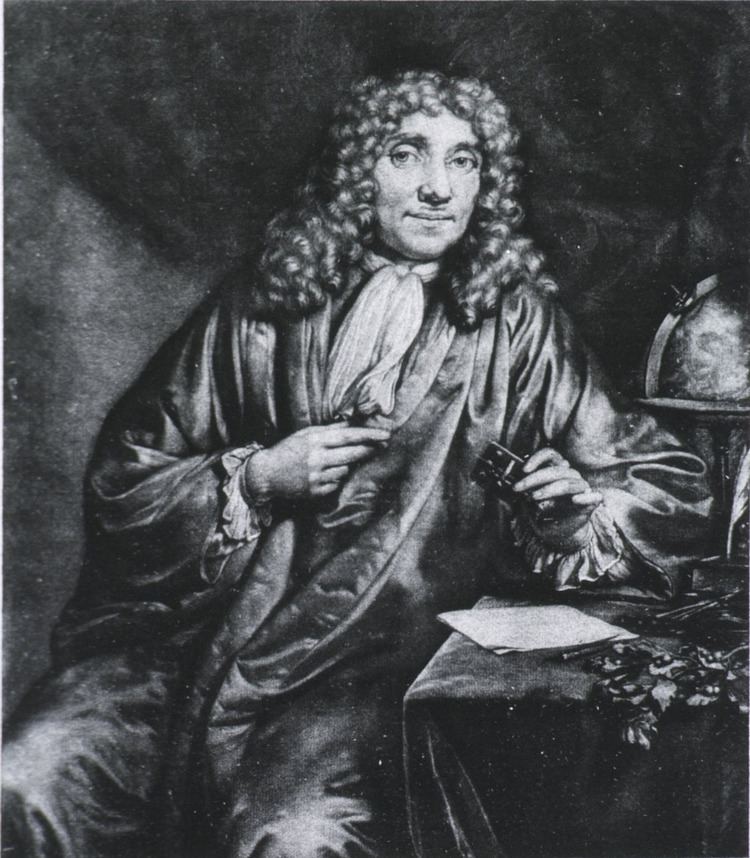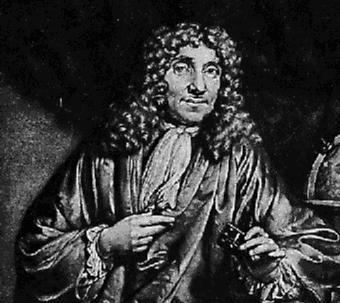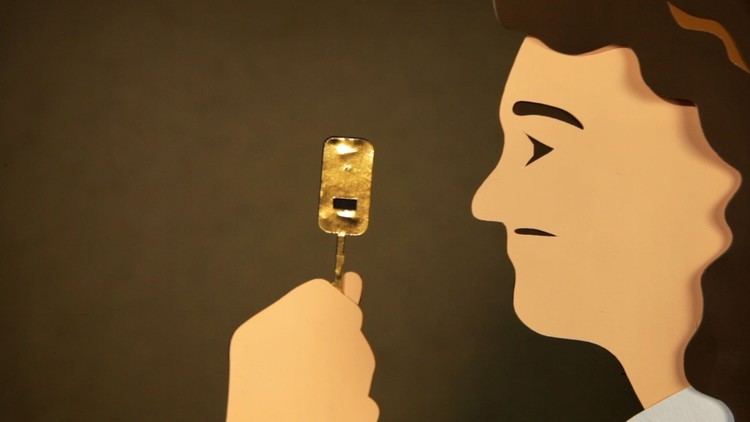Residence Netherlands Name Antonie Leeuwenhoek | Role Scientist | |
 | ||
Fields Microscopist and Biologist Spouse Barbara de Mey (m. 1654–1666) Books Antoni Van Leeuwenhoek and His Little Animals Siblings Geertruyt van Leeuwenhoek Similar People Robert Hooke, Matthias Jakob Schleiden, Theodor Schwann, Zacharias Janssen, Louis Pasteur Died 26 August 1723 (aged 90) Delft, Dutch Republic | ||
Antonie van leeuwenhoek biography
Antonie Philips van Leeuwenhoek (, [ɑnˈtoːni vɑn ˈleːuə(n)ˌɦuk]; 24 October 1632 – 26 August 1723) was a Dutch businessman, scientist, and one of the notable representatives of the Golden Age of Dutch science and technology. A largely self-taught man in science, he is commonly known as "the Father of Microbiology", and often considered to be the first acknowledged microscopist and microbiologist. Van Leeuwenhoek is best known for his pioneering work in the field of Microscopy and for his contributions toward the establishment of Microbiology as a scientific discipline.
Contents
- Antonie van leeuwenhoek biography
- Seeing the Invisible van Leeuwenhoeks first glimpses of the microbial world
- Early life and career
- Microscopic study
- Recognition by the Royal Society
- Scientific fame
- Techniques and discoveries
- Legacy and recognition
- References

Raised in Delft, in the Dutch Republic, van Leeuwenhoek worked as a draper in his youth and founded his own shop in 1654. He became well recognized in municipal politics and eventually, developed an interest in lensmaking. Using his handcrafted microscopes, he was the first to observe and describe microorganisms, which he originally referred to as animalcules (from Latin animalculum = "tiny animal"). His 1670s discovery and study of the hitherto unknown microscopic world (or microbial life) is also considered one of the most notable achievements of the Golden Age of Dutch exploration and discovery (ca. 1590s–1720s), similar to the Dutch discovery and mapping of largely unknown landmasses and far southern skies during the Age of Exploration.

Most of the "animalcules" are now referred to as unicellular organisms, although he observed multicellular organisms in pond water. He was also the first to document microscopic observations of muscle fibers, bacteria, spermatozoa, and blood flow in capillaries. Van Leeuwenhoek did not write any books; his discoveries came to light through correspondence with the Royal Society, which published his letters.
Seeing the Invisible: van Leeuwenhoek's first glimpses of the microbial world
Early life and career

Antonie van Leeuwenhoek was born in Delft, Dutch Republic, on 24 October 1632. On 4 November, he was baptized as Thonis. His father, Philips Antonisz van Leeuwenhoek, was a basket maker who died when Antonie was only five years old. His mother, Margaretha (Bel van den Berch), came from a well-to-do brewer's family. She remarried Jacob Jansz Molijn, a painter. Antonie had four older sisters, Margriet, Geertruyt, Neeltje, and Catharina. When he was around ten years old his step-father died. He attended school in Warmond for a short time before being sent to live in Benthuizen with his uncle, an attorney. At the age of 16 he became a bookkeeper's apprentice at a linen-draper's shop in Amsterdam, which was owned by the Scot William Davidson. Van Leeuwenhoek left there after six years.

Van Leeuwenhoek married Barbara de Mey in July 1654, with whom he fathered one surviving daughter, Maria (four other children died in infancy). That same year he returned to Delft, where he would live and study for the rest of his life. He opened a draper's shop, which he ran throughout the 1650s. His wife died in 1666, and in 1671, Van Leeuwenhoek remarried to Cornelia Swalmius with whom he had no children. His status in Delft had grown throughout the years. In 1660 he received a lucrative job as chamberlain for the assembly chamber of the Delft sheriffs in the city hall, a position which he would hold for almost 40 years. In 1669 he was appointed as a land surveyor by the court of Holland; at some time he combined it with another municipal job, being the official "wine-gauger" of Delft and in charge of the city wine imports and taxation.
Van Leeuwenhoek was a contemporary of another famous Delft citizen, the painter Johannes Vermeer, who was baptized just four days earlier. It has been suggested that he is the man portrayed in two Vermeer paintings of the late 1660s, The Astronomer and The Geographer, however, others argue that there appears to be little physical similarity. Because they were both relatively important men in a city with only 24,000 inhabitants, it is likely that they were at least acquaintances; Van Leeuwenhoek acted as the executor of Vermeer's will after the painter died in 1675.
Microscopic study
While running his draper shop, van Leeuwenhoek wanted to see the quality of the thread better than possible using magnifying lenses then available. He began to develop an interest in lensmaking, although few records exist of his early activity. Van Leeuwenhoek's interest in microscopes and a familiarity with glass processing led to one of the most significant, and simultaneously well-hidden, technical insights in the history of science.
By placing the middle of a small rod of soda lime glass in a hot flame, van Leeuwenhoek could pull the hot section apart to create two long whiskers of glass. Then, by reinserting the end of one whisker into the flame, he could create a very small, high-quality glass sphere. These spheres became the lenses of his microscopes, with the smallest spheres providing the highest magnifications.
Recognition by the Royal Society
After developing his method for creating powerful lenses and applying them to the study of the microscopic world, van Leeuwenhoek introduced his work to his friend, the prominent Dutch physician Reinier de Graaf. When the Royal Society in London published the groundbreaking work of an Italian lensmaker in their journal Philosophical Transactions of the Royal Society, de Graaf wrote to the editor of the journal, Henry Oldenburg, with a ringing endorsement of van Leeuwenhoek's microscopes which, he claimed, "far surpass those which we have hitherto seen". In response, in 1673 the society published a letter from van Leeuwenhoek that included his microscopic observations on mold, bees, and lice.
Van Leeuwenhoek's work fully captured the attention of the Royal Society, and he began corresponding regularly with the society regarding his observations. At first he had been reluctant to publicize his findings, regarding himself as a businessman with little scientific, artistic, or writing background, but de Graaf urged him to be more confident in his work. By the time van Leeuwenhoek died in 1723, he had written some 190 letters to the Royal Society, detailing his findings in a wide variety of fields, centered on his work in microscopy. He only wrote letters in his own colloquial Dutch; he never published a proper scientific paper in Latin. He strongly preferred to work alone, distrusting the sincerity of those who offered their assistance. The letters were translated into Latin or English by Henry Oldenburg, who had learned Dutch for this very purpose. Despite the initial success of van Leeuwenhoek's relationship with the Royal Society, soon relations became severely strained. In 1676, his credibility was questioned when he sent the Royal Society a copy of his first observations of microscopic single-celled organisms. Previously, the existence of single-celled organisms was entirely unknown. Thus, even with his established reputation with the Royal Society as a reliable observer, his observations of microscopic life were initially met with some skepticism.
Eventually, in the face of van Leeuwenhoek's insistence, the Royal Society arranged for Alexander Petrie, minister to the English Reformed Church in Delft; Benedict Haan, at that time Lutheran minister at Delft; and Henrik Cordes, then Lutheran minister at the Hague, accompanied by Sir Robert Gordon and four others, to determine whether it was in fact van Leeuwenhoek's ability to observe and reason clearly, or perhaps, the Royal Society's theories of life that might require reform. Finally in 1677, van Leeuwenhoek's observations were fully acknowledged by the Royal Society.
Antonie van Leeuwenhoek was elected to the Royal Society in February 1680 on the nomination of William Croone, a then-prominent physician. Van Leeuwenhoek was "taken aback" by the nomination, which he considered a high honor, although he did not attend the induction ceremony in London, nor did he ever attend a Royal Society meeting.
Scientific fame
By the end of the seventeenth century, van Leeuwenhoek had a virtual monopoly on microscopic study and discovery. His contemporary Robert Hooke, an early microscope pioneer, bemoaned that the field had come to rest entirely on one man's shoulders. He was visited over the years by many notable individuals, such as the Russian Tsar Peter the Great. To the disappointment of his guests, van Leeuwenhoek refused to reveal the cutting-edge microscopes he relied on for his discoveries, instead showing visitors a collection of average-quality lenses.
An experienced businessman, van Leeuwenhoek believed that if his simple method for creating the critically important lens was revealed, the scientific community of his time would likely disregard or even forget his role in microscopy. He therefore allowed others to believe that he was laboriously spending most of his nights and free time grinding increasingly tiny lenses to use in microscopes, even though this belief conflicted both with his construction of hundreds of microscopes and his habit of building a new microscope whenever he chanced upon an interesting specimen that he wanted to preserve. He made about 200 microscopes with a different magnification.
Van Leeuwenhoek was visited by Leibniz, William III of Orange and his wife, Mary II of England, and the burgemeester (mayor) Johan Huydecoper of Amsterdam, the latter being very interested in collecting and growing plants for the Hortus Botanicus Amsterdam, and all gazed at the tiny creatures. In 1698, van Leeuwenhoek was invited to visit the Tsar Peter the Great on his boat. On this occasion van Leeuwenhoek presented the Tsar an "eel-viewer", so Peter could study blood circulation whenever he wanted.
Techniques and discoveries
Antonie van Leeuwenhoek made more than 500 optical lenses. He also created at least 25 single-lens microscopes, of differing types, of which only nine have survived. These microscopes were made of silver or copper frames, holding hand-made lenses. Those that have survived are capable of magnification up to 275 times. It is suspected that van Leeuwenhoek possessed some microscopes that could magnify up to 500 times. Although he has been widely regarded as a dilettante or amateur, his scientific research was of remarkably high quality.
The single-lens microscopes of van Leeuwenhoek were relatively small devices, the largest being about 5 cm long. They are used by placing the lens very close in front of the eye, while looking in the direction of the sun. The other side of the microscope had a pin, where the sample was attached in order to stay close to the lens. There were also three screws to move the pin and the sample along three axes: one axis to change the focus, and the two other axes to navigate through the sample.
Van Leeuwenhoek maintained throughout his life that there are aspects of microscope construction "which I only keep for myself", in particular his most critical secret of how he made the lenses. For many years no-one was able to reconstruct van Leeuwenhoek's design techniques, however, in 1957, C.L. Stong used thin glass thread fusing instead of polishing, and successfully created some working samples of a van Leeuwenhoek design microscope. Such a method was also discovered independently by A. Mosolov and A. Belkin at the Russian Novosibirsk State Medical Institute.
Van Leeuwenhoek used samples and measurements to estimate numbers of microorganisms in units of water. He also made good use of the huge advantage provided by his method. He studied a broad range of microscopic phenomena, and shared the resulting observations freely with groups such as the British Royal Society. Such work firmly established his place in history as one of the first and most important explorers of the microscopic world. Antonie van Leeuwenhoek was one of the first people to observe cells, much like Robert Hooke.
Van Leeuwenhoek's main discoveries are:
In 1687, van Leeuwenhoek reported his research on the coffee bean. He roasted the bean, cut it into slices and saw a spongeous interior. The bean was pressed, and an oil appeared. He boiled the coffee with rain water twice and set it aside.
Like Robert Boyle and Nicolaas Hartsoeker, van Leeuwenhoek was interested in dried cochineal, trying to find out if the dye came from a berry or an insect.
Antonie van Leeuwenhoek's religion was "Dutch Reformed" Calvinist. He often referred with reverence to the wonders God designed in making creatures great and small. He believed that his amazing discoveries were merely further proof of the great wonder of God's creation.
Legacy and recognition
By the end of his life, van Leeuwenhoek had written approximately 560 letters to the Royal Society and other scientific institutions concerning his observations and discoveries. Even during the last weeks of his life, van Leeuwenhoek continued to send letters full of observations to London. The last few contained a precise description of his own illness. He suffered from a rare disease, an uncontrolled movement of the midriff, which now is named van Leeuwenhoek's disease. He died at the age of 90, on 26 August 1723, and was buried four days later in the Oude Kerk in Delft.
In 1981, the British microscopist Brian J. Ford found that van Leeuwenhoek's original specimens had survived in the collections of the Royal Society of London. They were found to be of high quality, and all were well preserved. Ford carried out observations with a range of single-lens microscopes, adding to our knowledge of van Leeuwenhoek's work.
Ford, as a Leeuwenhoek expert, wrote of him (1992):
“Antony van Leeuwenhoek remains one of the most imperfectly understood figures in the origins of experimental biology. The popular view is that Leeuwenhoek worked in a manner that was essentially crude and undisciplined, using untried methods of investigation that were lacking in refinement and objectivity. He has often been designated as a 'dilettante.' His microscopes, furthermore, have been described as primitive and doubt has been expressed over his ability to have made many of the observations attributed to him. Recent research shows these views to be erroneous."His work was carried out conscientiously, and the observations were recorded with painstaking diligence. Though we may see evidence of his globulist understanding of organic matter (and indeed, this view has frequently been cited as evidence of his observational inadequacies), this minor preoccupation cannot detract from two firm principles that underlie his work: (a) a clear ability to construct experimental procedures which were, for their time, rational and repeatable, and (b) a willingness both to fly in the face of received opinion – for example, over the question of spontaneous generation – and to abandon a previously held belief in the light of new evidence."In his method of analysing a problem, Leeuwenhoek was able to lay many of the ground rules of experimentation and did much to found, not only the science of microscopy, but also the philosophy of biological experimentation.”With regard to Leeuwenhoek's importance in history of microbiology and science in general, British biochemist Nick Lane has written (2015):
“More than being the first to see this unimagined world of 'animalcules', he was the first even to think of looking—certainly, the first with the power to see. Using his own deceptively simple, single-lensed microscopes, he did not merely observe, but conducted ingenious experiments, exploring and manipulating his microscopic universe with a curiosity that belied his lack of a map or bearings. Leeuwenhoek was a pioneer, a scientist of the highest calibre, yet his reputation suffered at the hands of those who envied his fame or scorned his unschooled origins, as well as through his own mistrustful secrecy of his methods, which opened a world that others could not comprehend.”The Antoni van Leeuwenhoek Hospital in Amsterdam, named after van Leeuwenhoek, is specialized in oncology.
In 2004, a public poll in the Netherlands to determine the greatest Dutchman ("De Grootste Nederlander") named van Leeuwenhoek the 4th-greatest Dutchman of all time.
On 24 October 2016, Google commemorated the 384th anniversary of van Leeuwenhoek's birth with a Doodle that depicted his discovery of "little animals" or animalcules, now known as bacteria.
Leeuwenhoek Medal, Leeuwenhoek Lecture, Leeuwenhoek (crater), Leeuwenhoeckia, Levenhookia (a genus of species in the family Stylidiaceae), and Leeuwenhoekiella (an aerobic bacterial genus) are named after him.
